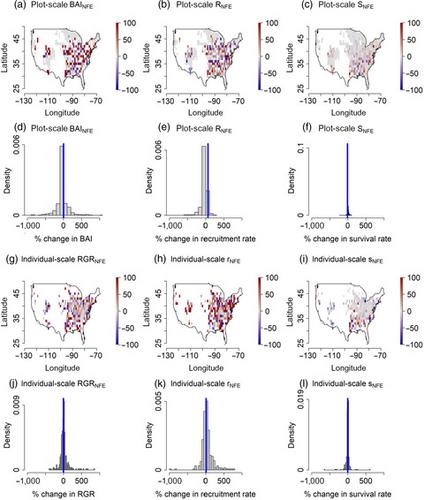Our official English website, www.x-mol.net, welcomes your feedback! (Note: you will need to create a separate account there.)
Nitrogen‐fixing trees have no net effect on forest growth in the coterminous United States
Journal of Ecology ( IF 5.5 ) Pub Date : 2020-10-06 , DOI: 10.1111/1365-2745.13513 Anika P. Staccone 1 , Sian Kou‐Giesbrecht 1 , Benton N. Taylor 2 , Duncan N.L. Menge 1
中文翻译:

固氮树木对美国毗邻的森林生长没有净影响
更新日期:2020-10-06
Journal of Ecology ( IF 5.5 ) Pub Date : 2020-10-06 , DOI: 10.1111/1365-2745.13513 Anika P. Staccone 1 , Sian Kou‐Giesbrecht 1 , Benton N. Taylor 2 , Duncan N.L. Menge 1
Affiliation

|
- Nitrogen (N)‐fixing trees fulfil a unique and important biogeochemical role in forests through their ability to convert atmospheric N2 gas to plant‐available N. Due to their high N fixation rates, it is often assumed that N‐fixing trees facilitate neighbouring trees and enhance forest growth. This assumption is supported by some local studies but contradicted by others, leaving the overall effect of N‐fixing trees on forest growth unresolved.
- Here we use the US Forest Service's Forest Inventory and Analysis database to evaluate the effects of N‐fixing trees on plot‐scale basal area change and individual‐scale neighbouring tree demography across the coterminous US.
- First we discuss the average trends. At the plot and individual scales, N‐fixing trees do not affect the relative growth rates of neighbouring trees, but they facilitate recruitment and inhibit survival rates, suggesting that they are drivers of tree turnover in the coterminous US. At the plot scale, N‐fixing trees facilitate the basal area change of non‐fixing neighbours.
- In addition to the average trends, there is wide variation in the effect of N‐fixing trees on forest growth, ranging from strong facilitation to strong inhibition. This variation does not show a clear geographical pattern, though it does vary with certain local factors. N‐fixing trees facilitate forest growth when they are likely to be less competitive: under high N deposition and high soil moisture or when neighbouring trees occupy different niches (e.g. high foliar C:N trees and non‐fixing trees).
- Synthesis. N‐fixing trees have highly variable effects on forest growth and neighbour demographics across the coterminous US. This suggests that the effect of N‐fixing trees on forest development and carbon storage depends on local factors, which may help reconcile the conflicting results found in previous localized studies on the effect of N‐fixing trees on forest growth.
中文翻译:

固氮树木对美国毗邻的森林生长没有净影响
- 固氮树通过将大气中的N 2气体转化为植物可利用的氮的能力而在森林中发挥独特而重要的生物地球化学作用。由于固氮率高,通常认为固氮树可促进邻域树木并促进森林生长。这一假设得到了一些当地研究的支持,但与其他研究相矛盾,这使得固氮树木对森林生长的总体影响尚未解决。
- 在这里,我们使用美国森林服务局的森林清单和分析数据库来评估固氮树对整个连续美国整个地块规模的基础面积变化和单个规模的邻近树木人口统计的影响。
- 首先,我们讨论平均趋势。在样地和个体尺度上,固氮树不会影响邻近树木的相对生长率,但是它们促进了募集并抑制了成活率,表明它们是美国近代树木更新的驱动力。在样地规模上,N棵固定树可促进非固定邻居的基础面积变化。
- 除了平均趋势外,固氮树对森林生长的影响还存在很大差异,范围从强烈的促进作用到强烈的抑制作用。尽管它随某些局部因素而变化,但这种变化没有显示出清晰的地理格局。当固氮树的竞争力下降时,它们会促进森林生长:在高氮沉降和高土壤湿度下,或者当相邻的树占据不同的生态位(例如高叶C:N树和非固树)时。
- 综合。固氮树对整个美国相邻地区的森林生长和邻里人口统计影响很大。这表明固氮树对森林发展和碳储存的影响取决于当地因素,这可能有助于调和先前关于固氮树对森林生长的影响的本地化研究中发现的矛盾结果。



























 京公网安备 11010802027423号
京公网安备 11010802027423号